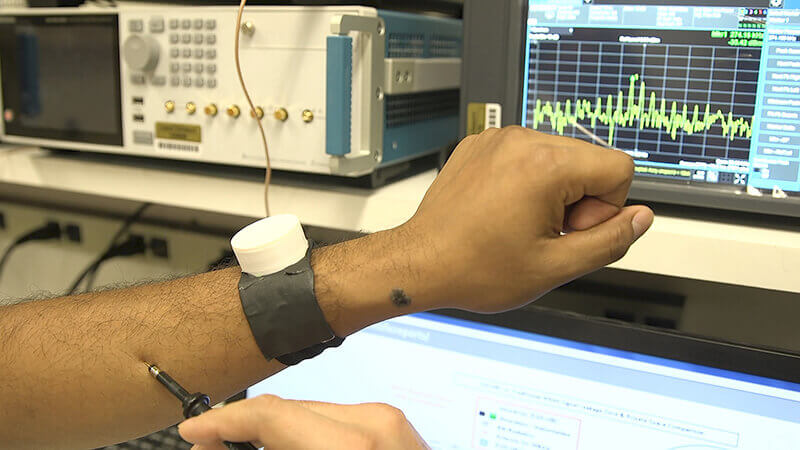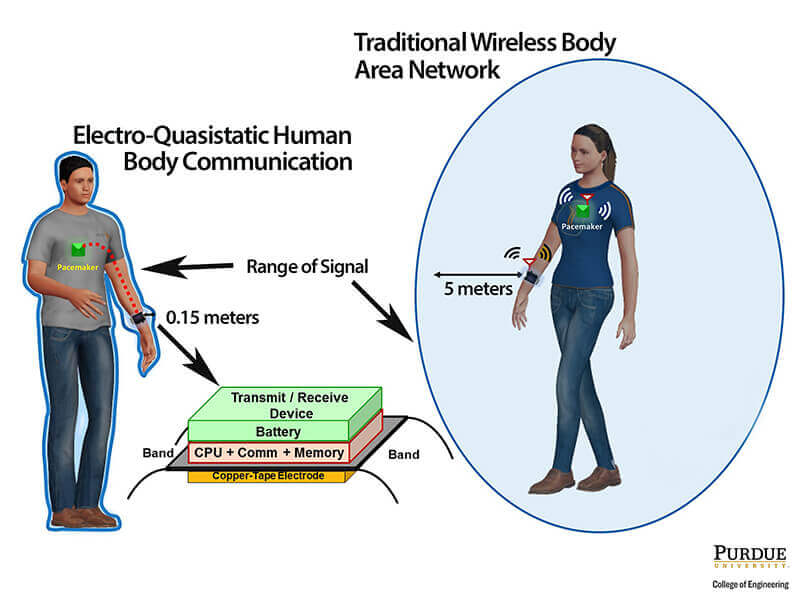March 12, 2019
Your body is your internet – and now it can't be hacked
Researchers have protected your pacemaker, other medical tech from remote hacks before they happen
WEST LAFAYETTE, Ind. — Someone could hack into your pacemaker or insulin pump and potentially kill you, just by intercepting and analyzing wireless signals. This hasn't happened in real life yet, but researchers have been demonstrating for at least a decade that it's possible.
Before the first crime happens, Purdue University engineers have tightened security on the "internet of body." Now, the network you didn't know you had is only accessible by you and your devices, thanks to technology that keeps communication signals within the body itself.
The work appears in the journal Scientific Reports. Study authors include Shreyas Sen, an assistant professor of electrical and computer engineering at Purdue, and his students, Debayan Das, Shovan Maity and Baibhab Chatterjee.
 The human body carries electrical signals well. Now these signals can be contained within close proximity of the body, thanks to new technology developed by Purdue University engineers. (Purdue University image/Erin Easterling)
Download image
The human body carries electrical signals well. Now these signals can be contained within close proximity of the body, thanks to new technology developed by Purdue University engineers. (Purdue University image/Erin Easterling)
Download image
"We're connecting more and more devices to the human body network, from smart watches and fitness trackers to head-mounted virtual reality displays," said Sen, who specializes in sensing and communication systems.
"The challenge has not only been keeping this communication within the body so that no one can intercept it, but also getting higher bandwidth and less battery consumption," he said.
Body fluids carry electrical signals very well. So far, so-called "body area networks" have used Bluetooth technology to send signals on and around the body. These electromagnetic waves can be picked up within at least a 10-meter radius of a person.
Sen's team has demonstrated a way for human body communication to occur more securely – not going beyond a centimeter off the skin and using 100 times less energy than traditional Bluetooth communication.
This is possible through a device that couples signals in the electro-quasistatic range, which is much lower on the electromagnetic spectrum. Sen's group is working with government and industry to incorporate this device into a dust-sized integrated circuit.
A YouTube video is available at https://youtu.be/NHqfT1vIe6E.
Through a prototype watch, a person can receive a signal from anywhere on the body, from the ears all the way down to the toes. The thickness of your skin or hair also doesn't really make a difference in how well you carry the signal, Sen says.
 A device keeps communication signals within the body, so that no one can hack into medical equipment such as pacemakers. (Purdue University image/Debayan Das)
Download image
A device keeps communication signals within the body, so that no one can hack into medical equipment such as pacemakers. (Purdue University image/Debayan Das)
Download image
The idea would be to create a way for doctors to reprogram medical devices without invasive surgery. The technology would also help streamline the advent of closed-loop bioelectronic medicine – in which wearable or implantable medical devices function as drugs, but without the side effects – and high-speed brain imaging for neuroscience applications.
"We show for the first time a physical understanding of the security properties of human body communication to enable a covert body area network, so that no one can snoop important information," Sen said.
The technology has received multiple patents through the Purdue Research Foundation Office of Technology Commercialization.
This work was supported by the Air Force Office of Scientific Research YIP Award (FA9550-17-1-0450) and the National Science Foundation CRII Award (CNS 1657455).
The research also aligns with Purdue's Giant Leaps celebration, acknowledging the university’s global advancements made in health, longevity and quality of life as part of Purdue’s 150th anniversary. This is one of the four themes of the yearlong celebration’s Ideas Festival, designed to showcase Purdue as an intellectual center solving real-world issues.
Writer: Kayla Wiles, 765-494-2432, wiles5@purdue.edu
Source: Shreyas Sen, 765-496-6520, shreyas@purdue.edu
Note to Journalists: The paper is available online open-access at https://www.nature.com/articles/s41598-018-38303-x. A YouTube video is available at https://youtu.be/NHqfT1vIe6E and other multimedia can be found in a Google Drive folder at http://bit.ly/sen-media. The materials were prepared by Erin Easterling, digital producer for the Purdue College of Engineering, 765-496-3388, easterling@purdue.edu.
ABSTRACT
Enabling covert body-area network using electro-quasistatic human body communication
Debayan Das, Shovan Maity, Baibhab Chatterjee, Shreyas Sen
Purdue University, West Lafayette, IN, USA
doi: 10.1038/s41598-018-38303-x
Radiative communication using electro-magnetic (EM) fields amongst the wearable and implantable devices act as the backbone for information exchange around a human body, thereby enabling prime applications in the fields of connected healthcare, electroceuticals, neuroscience, augmented and virtual reality. However, owing to such radiative nature of the traditional wireless communication, eM signals propagate in all directions, inadvertently allowing an eavesdropper to intercept the information. In this context, the human body, primarily due to its high water content, has emerged as a medium for low-loss transmission, termed human body communication (HBC), enabling energy-efficient means for wearable communication. However, conventional HBC implementations suffer from significant radiation which also compromises security. In this article, we present Electro-Quasistatic Human Body Communication (eQs-HBC), a method for localizing signals within the body using low-frequency carrier-less (broadband) transmission, thereby making it extremely difficult for a nearby eavesdropper to intercept critical private data, thus producing a covert communication channel, i.e. the human body. This work, for the first time, demonstrates and analyzes the improvement in private space enabled by EQS-HBC. Detailed experiments, supported by theoretical modeling and analysis, reveal that the quasistatic (QS) leakage due to the on-body EQS-HBC transmitter-human body interface is detectable up to <0.15 m, whereas the human body alone leaks only up to ~0.01 m, compared to >5 m detection range for on-body eM wireless communication, highlighting the underlying advantage of eQs-HBC to enable covert communication.
Related website
Sensing, Processing, Analytics and Radio Communication (SPARC) Lab

